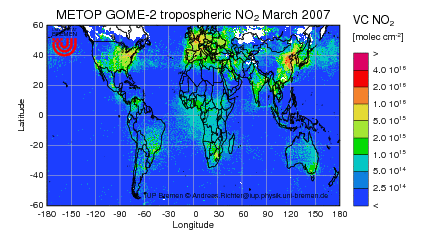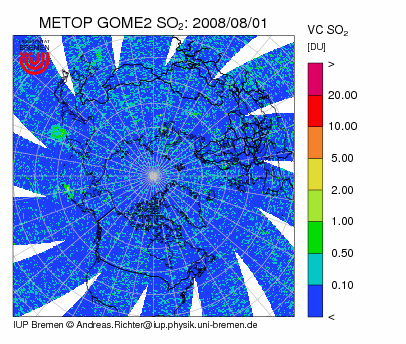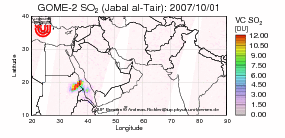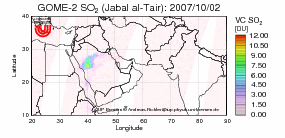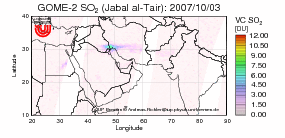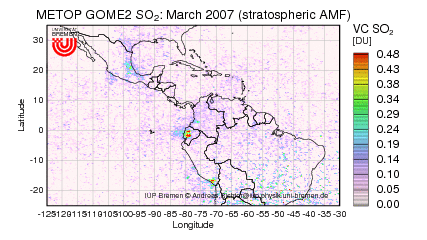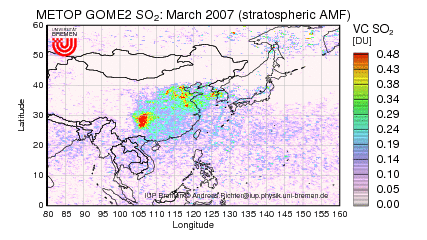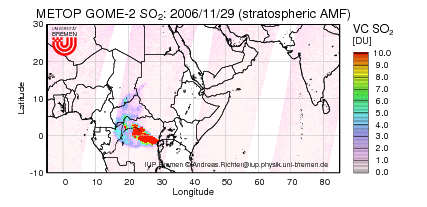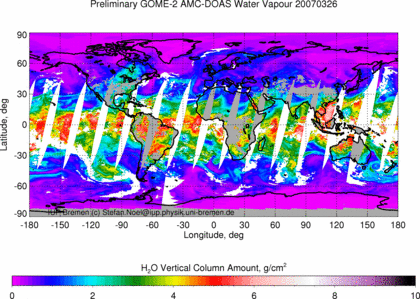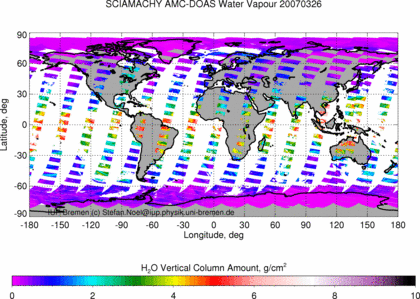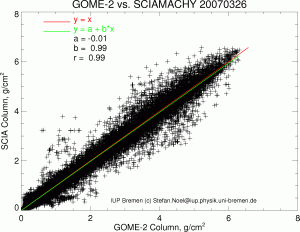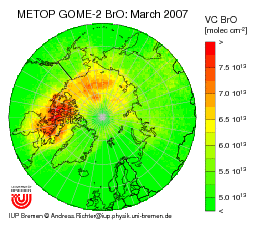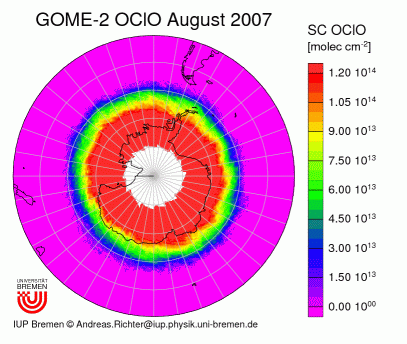
First GOME-2 nadir DOAS results
NO2 SO2 H2O BrO OClO Contact EUMETSAT Disclaimer
This page is available only for archiving reasons. Much more data and information is available on the pages for individual products and on our GOME-2 data browser page.
Since Janauary 2007, first spectra from the GOME-2 instrument on MetOp are available from EUMETSAT. Although the spectra are not yet fully calibrated and validated, they already can be used to demonstrate the potential of the new instrument.
Compared to GOME, the main differences of GOME-2 are the improved spatial resolution and the much better coverage.
Below, you will find some examples of GOME-2 nadir measurement analysed with the DOAS algorithm. Please remember that these results are preliminary only as they are based on not fully validated radiances and a quick and dirty analysis! They should be taken as "proof of concept" rather than as an quantitative data evaluation.
 NO2:
NO2:
Tropospheric NO2 columns are derived using the same fitting window, reference sector approach, cloud screening and airmass factors as for the GOME and SCIAMACHY data. The map below shows the average over all data available for March 2007. Please note that this is based on much less data than a monthly average in nominal operation.
The overall pattern is very similar as in GOME and SCIAMACHY data, highlighting industrialised regions and areas with intense biomass burning. Also, the shipping lane between India and Indonesia can clearly be identified.
 SO2:
SO2:
The SO2 retrieval on GOME-2 data is using the same settings as for GOME and SCIAMACHY. Both large anthropogenic pollution sources e.g. over China ore from the smelters in South America and volcanic emissions can be identified in the monthly averages shown below. The airmass factor used is more appropriate for large volcanic eruptions, leading to significant underestimation of the real SO2 columns in these figures.
The eruption of the Kasatochi volcano in Alaska emitted large amounts of SO2 into the atmosphere which can be tracked in GOME-2 measurements over many days:
In an early GOME-2 measurement in November 2006, a large SO2 plume was detected over Africa which can be directly compared to the corresponding OMI measurement taken several hours later (click on image for enlarged comparison).
 H2O:
H2O:
Total water vapour columns are derived using the Air Mass Corrected (AMC-)DOAS approach, which has already been applied successfully to GOME and SCIAMACHY data.
Compared to the GOME instrument, GOME-2 has a higher spatial resolution (80 km x 40 km, comparable to the SCIAMACHY resolution of typically 60 km x 30 km) and a larger swath width of 1920 km, resulting in a daily coverage at mid and high latitudes. The enhanced coverage of GOME-2 can be seen from the following maps which show the derived GOME-2 (left) and SCIAMACHY (right) water vapour columns for one day (26 March 2007).
An eye inspection of these swath data already reveals that the observed water
vapour structures agree quite well. This is confirmed by a more quantitative
analysis for which all data are spatially gridded to 0.5 deg x 0.5 deg and
compared. A scatter plot of all resulting collocated data points of GOME-2 and
SCIAMACHY for this day is shown in the Figure below.
Obviously, the agreement between the two data sets is quite good. However, this
is only a single day example for a comparison between GOME-2 and SCIAMACHY water
vapour columns. A more extensive statistical analysis will be performed when
more GOME-2 data are available.
For more information on GOME-2 water vapour please contact
Stefan
NoŽl.
 BrO:
BrO:
BrO columns are retrieved using the settings developed for SCIAMACHY data retrieval. The airmass factor used is appropriate for stratospheric BrO and therefore boundary layer BrO over ice will be overestimated while over dark surfaces it will be underestimated. No cloud screening is applied so far as this is difficult over snow and ice.
The monthly average BrO map retrieved shows the spatial distribution and absolute columns expected for this season with slightly higher than expected values in mid-latitudes. This is currently under investigation.
The excellent spatial coverage at constant spatial resolution facilitates tracking of the development and transport of BrO plumes in the Arctic boundary layer, nicely demonstrating the life time and long range transport of these events. This is shown in the animation below.
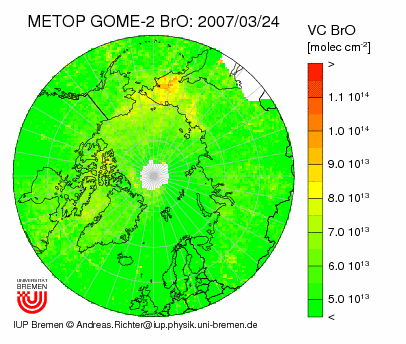
 OClO:
OClO:
OClO columns are retrieved using the settings developed for GOME and SCIAMACHY data retrieval. OClO is only present at twilight as it photolyses rapidly. OClO is an indicator of chlorine activation and is only observed in the activated polar vortex.
The monthly average OClO map retrieved is in good agreement with results from SCIAMACHY but had to be manually corrected for an offset. The origin of this offset and possible solutions are currently under investigation.
 Contact:
Contact:
If you are interested in more information on first GOME-2 DOAS results, please contact Andreas Richter.
For more information on GOME-2 water vapour results please contact Stefan NoŽl.
 EUMETSAT Disclaimer:
EUMETSAT Disclaimer:
As the GOME-2 instrument is still in commissioning phase, please note the EUMETSAT disclaimer:
"Users should note that the early access to EPS data is provided by EUMETSAT on a best effort basis, without full service commitment. Data delivered during commissioning are not considered to be validated data. A full assessment of the quality of the calibration has yet to be completed, so whilst the calibration data are believed to be acceptable for this stage of commissioning EUMETSAT provides no guarantee of quality"
More on the instrument and the mission can be found on the EUMETSAT GOME-2 pages and the ESA GOME-2 pages.
